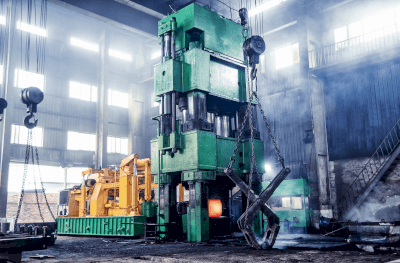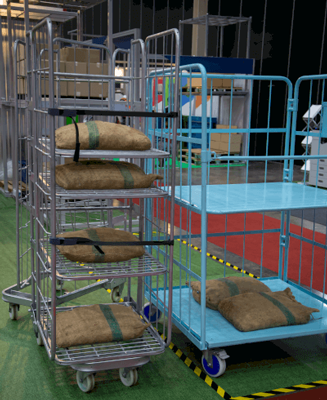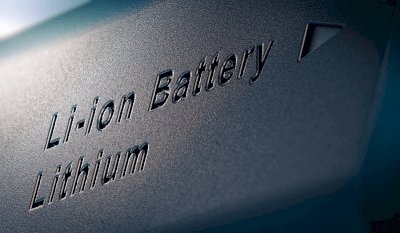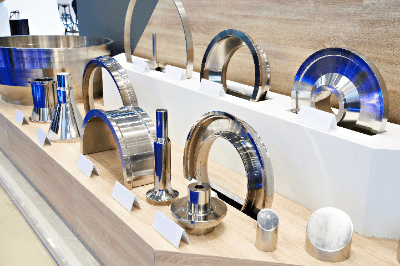What Is Forging Machinery?

Forging machinery is a machine used to shape or forge metal materials by applying pressure to them.
Forging machinery can be broadly divided into hammers and presses. These include air hammers and steam hammers that use compressed air or steam, as well as drop hammers that drop large hammers by gravity. Presses, on the other hand, are classified into hydraulic presses and mechanical presses based on the method of load generation.
While hammers can apply large pressure, it is difficult to control the load, making high-precision forging difficult. Mechanical presses are used, especially when precision forging is required.
Uses of Forging Machinery
Forging machinery is used in the manufacturing and processing of hardware, such as kitchen knives and pliers, as well as automotive and aircraft parts that require high-strength metal materials.
Forging machinery is used for automotive parts such as crankshafts, gears, tire wheels, and bearing races. In aircraft parts, they are often used for jet engine parts and fuselage frames.
Other industrial parts include bolts, couplings, and valves. Forging Machinery is used when high strength is required and parts are not easily deformed when heated.
Principle of Forging Machinery
Forging has long been used as a processing method to shape metal materials by striking them. The process by which forging increases the strength of metal is fairly well understood.
When metal is compressed and stretched sufficiently by forging, a crystalline structure called a metal flow line (forging flow line) is formed. This metal flow plays an important role, but castings that are not forged do not have metal flow and are not strong enough to withstand bending stresses.
In forged metal, metal flow follows the shape of the material, making the metal stronger and more durable. Forging Machinery strikes the metal with a hammer or press to produce metal flow.
In hammer forging, the weight of the ram or compressed air is used to impact the metal strongly. Presses, on the other hand, use hydraulic pressure to pressurize a cylinder forcefully or convert the rotational motion of a motor into linear motion by means of a crank.
Types of Forging Machinery
1. Hammer Forging Machinery
Forging hammers are forging machines mainly used in hot forging. There are pneumatic hammers, counterblow pneumatic hammers, spring hammers, etc.
Pneumatic Hammer
A pneumatic hammer is a machine that blows and shapes a workpiece by accelerating and dropping a driving unit called a ram by air pressure. It is characterized by its high impact energy.
Counterblow Air Hammer
The workpiece is pulled up from the jig at the same time as the ram drops and struck. It is characterized by increased pressure and low vibration.
SpringHammer
This is a small general-purpose hammer that uses the force of a spring. Compared to manual forging, it has higher productivity and less variation in the striking marks, but it requires a skilled operator.
2. Press Forging Machinery
Forging Machinery can be classified by power: mechanical presses, hydraulic presses, and servo presses.
Mechanical Presses
One of the mechanical presses is a press that applies pressure to a workpiece by converting the rotational motion of a flywheel into the sliding motion of a ram for power. The slide cannot be stopped at any given position, but the processing speed is high and productivity is excellent. Automated lines are possible. It is often used for mass-produced cold forging.
In addition to the flywheel type, there are other types of mechanical presses, such as crank presses, knuckle presses, and screw presses.
Hydraulic Presses
Hydraulic presses are machines that press workpieces using hydraulic or water pressure. They are widely used, from large products for small lots to small products for mass production.
Since the slide can be stopped at any position, prototypes and material deformation tests can be performed. The slow pressurization speed makes it unsuitable for hot forging of small parts that are prone to heat dissipation.
Hydraulic forging presses are the mainstream, but hydraulic forging presses are also used for hot forging of large products due to ease of maintenance, safety, and price. Forging Machinery is used for hot forging of large products such as turbines for thermal power generation and generator rotors.
Servo Presses
Servo forging presses use a servo motor to slide a ram directly. Because it is driven by a servomotor, precise control of pressurization and an amount of pressure is possible.
Servo presses can improve productivity by controlling the pressurizing speed and reduce yield by controlling the amount of pressurization. Forging of difficult-to-machine materials such as magnesium and complex shapes is also possible.



